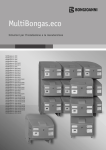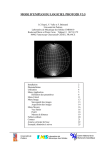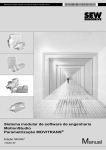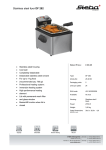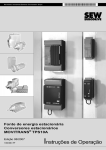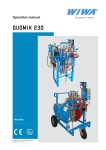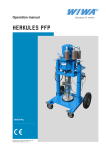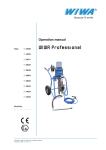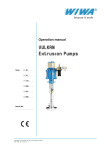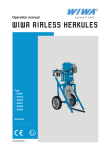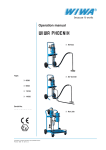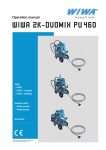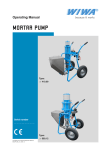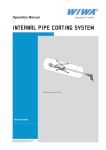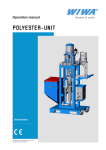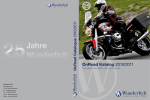Download Operation manual Low pressure pumps
Transcript
Operation manual Low pressure pumps Low Pressure Pumps Water Pumps Oil Transfer Pumps 150. ... 375. ... 402. ... 600. ... 702. ... 1052. ... 150. ... 40. ... 75. ... 82. ... Transfer Pumps Serial-No. …………………… Translation of the original operation manual low pressure pumps NDP · DBK · en · 01.12 · ju Rapid Pumps 2:1 4:1 4,5:1 6:1 7:1 9:1 10:1 100. ... 200. ... Contents 1 Contents 1.1 Preface This User’s Handbook must always be available to operating staff! The operating authority of the equipment must ensure, that a User`s Handbook is available to the operator, in a language which he understands! Dear customer! Thank you for your decision to purchase equipment. In the User’s Handbook, you can find all information required Low Pressure Pump. for the proper handling of your However, for safe operation, there are further essential details which you should adhere to: Please read and observe the guidlines valid for your country. In Germany, the "Richtlinien für Flüssigkeitsstrahler" (Guidelines for fluid sprayers) published by: Hauptverband der Gewerblichen Berufsgenossenschaften (Industrial Employer's Liability Insurance Association), are valid. Manufacturer’s notes and operating guidelines for coating and pumping materials should be observed at all times. No method of operation should be exercised which impairs the safety of products and the operating personnel. We wish you much success and excellent working results when appliying your Low Pressure Pump. WIWA Wilhelm Wagner GmbH & Co.KG. 1.2 Table of contents 1 1.1 1.2 Contents................................................................. 3 Preface.................................................................... 3 Table of contents..................................................... 3 2 2.1 2.2 2.3 2.4 2.5 2.6 2.7 2.8 2.9 2.10 Safety..................................................................... 4 Description of symbols............................................ 4 Warning instructions located on the machine......... 4 Dangers arising from the equipment....................... 4 Generally Authorized Usage................................... 5 Machine surroundings............................................. 6 Sources of danger................................................... 6 Operating staff......................................................... 7 Behavior in case of emergency............................... 8 Protective equipment.............................................. 8 Handling of the machine and auxiliary materials..... 9 3 3.1 3.2 Machine description........................................... 10 Low Pressure and Water Transfer Pumps............ 10 Low Pressure, Water Transfer Pumps and DA-pumps..............................................................11 4 Installation / Transportation............................... 12 5 5.1 5.2 5.3 Initial operation and assembly........................... 12 Assembly............................................................... 12 Initial Operation..................................................... 12 First Cleaning........................................................ 12 6 6.1 6.2 Operation............................................................. 13 General Instructions.............................................. 13 Compact Instructions: Conventional Spraying Method............................. 14 Compact Instructions: LP Pump as Transfer Pump.................................. 14 6.3 Copyright © 2009 WIWA Copyright ownership for this user manual remains with WIWA WILHELM WAGNER GmbH & Co. KG Gewerbestraße 1-3 • 35633 Lahnau Phone: +49 (0)6441 609-0 • Fax: +49 (0)6441 609-50 • E-mail: info@ wiwa.de • Internet: www.wiwa.de This operating manual is solely intended for personnel involved in preparation, operation and servicing. It is prohibited to pass on this operating manual for reproduction, utilisation or communication of its contents, unless this has been explicitly permitted. Infringements incur an obligation to pay damage compensation. All rights reserved in the event of registration of the patented design, industrial design or registered design. This operating manual only applies in conjunction with the machine card that was given to you with the user manual for your equipment. Please check that the type plate data is identical with the information on the machine card. Please notify us immediately if there are discrepancies, if the user manual has been incorrectly compiled or if the type plate is missing. 7 7.1 7.2 7.3 7.4 Service / Repair................................................... 15 Testing................................................................... 15 Lubricating Fluid and Packings............................. 15 Maintaining the Air Maintenance Unit.................... 16 Material Filter........................................................ 17 8 Disturbances during operation and Troubleshooting................................................................. 19 9 9.1 9.2 Compact Instructions......................................... 20 Follower Plate / Follower Cover............................ 20 Ram Press / Single-Post Ram Press.................... 21 10 10.1 10.2 10.3 10.4 Appendix.............................................................. 22 Technical specifications......................................... 22 Machinery materials.............................................. 23 Certificate of Training and Operation.................... 24 Machine card and spare parts lists....................... 24 Translation of the original operation manual low pressure pumps NDP_BAoDB • en • 01.10 • ju 3 Safety 2 Safety 2.1 Description of symbols The signs and symbols used in this manual have the following meaning: STOP marks a section of text which is especially relevant to safety. Special attention should be paid to this section and it's contents strictly observed. WARNING marks a situation which could be dangerous. If not observed,death or very serious injuries could result. DANGER OF EXPLOSION marks a situation where there is danger of explosion. Observation of this information is absolutely essential. ELECTRICAL VOLTAGE marks a situation where there is a danger of explosion through an electostatic charge. Observation of this information is absolutely essential. USE EAR PLUGS For health reasons, it is very important to pay attention to this warning. USE BREATHING PROTECTION For health reasons, it is very important to pay attention to this warning. HEALTH DANGER marks materials which are hazardous to your health. Observation of this information is absolutely essential. FIRST AID In case of injuries or accidents, these instructions should be absolutely adhered to. 2.2 Warning instructions located on the machine Warning signs and symbols which have been placed on the machine are there to inform of possible dangers and must be observed. Warning signs and symbols may not be removed from the machine. Damaged and illegible warning signs and symbols are to be replaced immediately. 4 The following signs are located on the machine: Warning sign covering the grounding of the machine - Only found on units having a fluid filter The propietor is required according to the German Accident Prevention Regulation (Unfallverhütungsvorschrift), BGR 500, Kap. 2.25, to ensure that the machine is properly grounded. Please, observe our operation manual. Nameplate Please observe that the information located on the typeplate corresponds to data found on the machine card. We request immediate notification should there be any discrepancies or if the typeplate is missing. 2.3 Dangers arising from the equipment This machine was designed and built in accordance with all safety aspects. It corresponds with the present standards of technical regulations and current rules for accident prevention. It left the factory in perfect condition and ensures a high level of safety. However, the following dangers exist if operated incorrectly or used inappropriately: to life and limb of operator or third persons for the machine and other property belonging to owner of machine for the efficient working of the machine All personnel involved in the starting, operation and maintenance of the machine must read the following notes carefully and observe them. It is a matter of their safety! We recommend that the machine operation management have this confirmed in writing. Additionally, please pay attention to the following: Please, read and observe the guidlines valid for your country. In Germany the "Richtlinien für Flüssigkeitsstrahler" (Guidelines for liquid sprayers) Published by: Hauptverband der Gewerblichen Berufsgenossenschaften (Industrial Employer's Liability Insurance Associations), are valid. We recommend adding a copy of all guidelines and accident prevention regulations into the user's manual. Manufacturer’s notes and operating guidelines for coating material and pumping material should be observed at all times. In principle, no method of working should be exercised which impairs the safety of WIWA products or the operating personnel. Translation of the original operation manual low pressure pumps NDP_BAoDB • en • 01.10 • ju Safety 2.4 Generally Authorized Usage Low pressure pumps are designed to be used for paint supply in paint circulation systems and dispensing stations, as well as for conventional paint spraying in trade and industry. Depending upon the version, low pressure pumps can be used to process lacquers and paints, regardless of viscosity; water lacquer; solvent; oil and grease; stripping agent; mordant materials; glue; pasty materials; jointing compound, adhesive; bitumen; epoxy materials; underseal; roof coating and insulating materials; sound insulation and other high-viscosity materials with high solids contents. Depending on the material to be processed, these pumps are designed with the corresponding packings and are available in carbon steel and stainless steel versions. Long version low pressure pumps can be used as immersion pumps. When being used in paint circulation systems (constant delivery), the pumps should not be run faster that 20 cycles per minute. Your pump is especially designed to process the material you specify only. Other usage is not in line with regulations. Before WIWA equipment is used for other purposes or with other materials, and, therefore, not according to the regulations, permission should be obtained from the manufacturer, as the guarantee is otherwise invalid. The observation of technical documentation and the compliance with specified operational, maintenance and starting guidelines are manditory in accordance with the valid regulations. The following table specifies which low pressure pumps are applicable for various materials: Type of pump Low Pressure Pump Series 150; 375; 402; 600; 702, 1052 Series Rapid 200; 100 Oil Transfer Pumps (Series 40; 82) Water Pumps (Series 75; 150) Transfer Pumps (Series DA…) Material to be processed Lacquer and Paint, Water Lacquer Solvent, Oil (low viscosity materials) Using this equipment in areas requiring protection from explosions Only applies for low pressure pumps, water pumps and the oil transfer pump 0623709!! Marking: II 2G cT4 This equipment fulfills the explosion-proof requirements found in the guideline 94/9/EC (ATEX 95 for the type of explosion, equipment catagory and temperature class found on the nameplate). This equipment is able to be installed in areas requiring Zone I explosion protection. Due to the possibility that explosive gases and overspray may be created, this unit is to be considered as Group II, Equipment Catagory 2G. The flash point for the materials being sprayed, as well as the solvent being used, must be above 200°C. This corresponds to the temperature class T3. When operating this equipment, the User‘s Handbook must be followed closely. The required inspection and maintenance intervals must be adhered to strictly. All information found on the unit‘s signs or plates must be adhered to and not exceeded. Do not allow this unit to be overloaded. It is the responsibility of the operator of this equipment to determine the explosion risk (zone determination according to EC regulation 94/9/EC, Appendix II, Nr. 2.1-2.3) in the area of usage, in accordance with local regulatory authority guidelines. Furthermore, it is the responsibility of the operator on-sight to check and ensure that the technical specifications and markings according to ATEX are compliant with local requirements. Please observe that some components have their own nameplate with separate markings according to ATEX. The marking with the lowest rating for explosion protection becomes valid for the entire system. If the intended application could lead to injury of personnel if this equipment malfunctions, on-sight precautions and preventive measures must be implemented If this equipment appears to be malfunctioning or behaving strangely during operation, the unit must be shut down immediately and WIWA Customer Service contacted as soon as possible. It must be ensured that the unit is grounded either separately or together with the equipment it is mounted to (maximum resistance 106 Ω, picture 2.4.1 Grounding / Equalizing Potential). Oil and Grease Water Adhesive, Glue, Lacquer and Paint Fig. 2.4.1 ground screw on the high pressure filter Translation of the original operation manual low pressure pumps NDP_BAoDB • en • 01.10 • ju 5 Safety 2.5 Machine surroundings Rebuilds and changes For safety reasons, it is not allowed to carry out rebuilds or changes without authorization. Protective equipment may not be dismounted, modified or neglected. If using components which are not produced or delivered by WIWA, warranty coverage is negated as well as liability. The machine may only be operated within the prescribed limits and machine parameters. Danger caused by attachments and spare parts If you use original attachments and original spare parts from WIWA Wilhelm Wagner GmbH & Co. KG, the compatibility with our equipment is guaranteed. It is, however, essential that the safety regulations of the attachments and spare parts are observed. You can find these safety regulations in the User’s Handbook, located with the spare parts lists. If you use attachments and spare parts from another source, WIWA cannot guarantee the safety of the entire system. In this case, our guarantee does not cover any damage or injury caused by such attachments and spare parts. Emissions It is possible for solvent vapours to occur, depending on the materials used. Therefore, please ensure the workplace is sufficiently ventilated in order to avoid damage to health and property. Always observe the processing information given by the material manufacturer. The sound pressure level of the equipment is below 85 db(A). Nevertheless, appropriate means of noise protection should be made available to the operating staff. The operator is responsible for compliance with the rules covering the prevention of accidents due to „noise“ (VGB 121). Therefore, pay special attention to the environmental conditions at the site, e. g. noise can be increased if the machine is installed in or on hollow bodies. Exact details regarding noise emission are mentioned in the Chapter 9.1 Technical specification. 2.6 Sources of danger Observe that low pressure pumps can cause life threatening injuries if used improperly. Pay attention to the following notes: ➤➤ Never try to seal leaks on joints and high pressure hoses with your hand or by binding the spot. Should a leak occur, the whole system (gun, hose, pressure filter, pump, etc.) are to be depressurized immediately. 6 Defective parts are to be replaced. ➤➤ If working with heated materials, always wear the proper hand protection. BURN DANGER! ➤➤ Material hoses must conform to the prescribed maximum working pressure, allowing for a suitable saftey factor. Material hoses are never to be „patched“! ➤➤ The entire system is to be depressurized before maintenance and cleaning work is carried out. Interrupt the inbound air supply for the entire system. Close the air stop cock. ➤➤ It is possible for a static charge to occur due to the high flow speeds during the airless spraying procedure. Static charges can lead to fire and explosions. The equipment must, therefore, always be appropriately grounded. When using a WIWA Fluid Heater ensure to connect a grounding cable to the ground screw (Picture 2.6.1). Picture 2.6.1 ➤➤ Never use this equipment outdoors during a thunderstorm. ➤➤ Transfer pumps that are not protected against explosions may not be used in workplaces which fall under the regulation covering explosion protection. Pneumatically driven WIWA Low Pressure Pumps are not affected by this. Should, however, additional electrically driven accessories be mounted to these machines, such as agitators or heaters, the regulation covering explosion prevention must be checked for compliance. Electrical plugs for heaters, agitators, etc. which are not protected against explosions may only be plugged into sockets located outside of areas that fall under the regulation covering explosion prevention, even if the accessory being used is explosion protected. ➤➤ Due to electrostatic charges, only conductive material hoses should be used. All original WIWA material hoses are conductive and compatible with our equipment. The maximum admissible working pressure on the hoses must correspond to the maximum operating pressure of each airless machine. ➤➤ If the material being used clogs or clumps within the machine, residual pressure may still exist despite depressurization efforts. This must be kept in mind when carrying out repairs! Special care must be taken when dismantling the fluid filter, material hoses and high pressure spray gun to ensure that no accidents occur due to residual pressure. Translation of the original operation manual low pressure pumps NDP_BAoDB • en • 01.10 • ju Safety ➤➤ When working on the fluid filter, for example to change the filter, the machine must first be turned off and depressurized. ➤➤ Never remove the safety valve fitted and sealed on the operation side, and never adjust its setting. ➤➤ Should the safety valve need replacing, please see the machine card for its order number. ➤➤ Please ensure that new safety valves are set and sealed to the maximum permitted air inlet pressure for the WIWA Low Pressure Pumps(see type plate/machine card). ➤➤ During operation, ensure that sufficient feed of material is available to the pump in order to avoid heating due to friction, caused when the material pump runs dry. Observe closely: –– no empty feed containers may be present during operation –– the suction system may not be clogged, buckled or defect in any other way –– if the unit stops processing material, shut it down immediately ➤➤ In closed or pressurised systems where aluminium or galvanised parts come into contact with the solvent, dangerous chemical reactions can occur if 1.1.1-Trichlorethylene, Methylene Chloride or other solvents containing halogenated chlorinated hydrocarbons (CFCs) are used. If you wish to work with the above solvents, or with lacquers and paints which contain them, we recommend you contact either WIWA customer services or WIWA directly. ➤➤ We call your attention to the fact that a series of low pressure pumps, including versions which are rust and acid-proof, is available for such materials. ➤➤ The maximum operating pressures given by us are to be adhered to in principle for all WIWA parts (eg. pump, heater, hoses, gun, safety valve). ➤➤ The inbound air pressure must be clearly visible on a pressure gauge. WIWA pumps equipped with either an air maintenance unit or pressure regulator come standard with a pressure gauge. ➤➤ Smoking, open flames or any other possible ignition sources are not allowed anywhere near the area of operation If using your low pressure pump for conventional spraying, please observe the following instructions: ➤➤ Never point the spray gun towards yourself, other people or other living creatures. ➤➤ Never hold your finger or hand in front of the gun and never reach into the spray. ➤➤ The gun is to be secured, and the safety device checked, during every interruption while working, regardless how short. ➤➤ Never spray solvents or materials containing solvents into a narrow-necked can or barrels with bung hole. DANGER OF EXPLOSION! Please, always use an open container. Due to possible electro static charges, it is imperative to ensure that the spraying gun has contact to the container walls when working with metal containers. 2.7 Operating staff Authorised Operators People under the age of 16 should not operate this equipment. The management in charge of the operation of the machine must make the user’s handbook available to the operator and must make sure that he has read and understood it. Only then may the system be put into operation. We recommend the manager has this confirmed in writing. The operator of the machine is obliged to report any changes in the machine which might affect its safety to the manager, as he must ensure that the machine is functional. The responsibilities for the different activities on the system must be laid down clearly and adhered to. No unclear responsibilities may remain as these could endanger the safety of the users. The operator must make sure that only authorised persons work on the machine. He is responsible to third parties in the working vicinity of the system. Personal protective equipment ➤➤ We call to your attention that the valid guidelines and requirements in accordance with work surroundings (mining, closed areas etc.) must be absolutely adhered to. ➤➤ Always wear the prescribed protective clothing, including glasses and gloves (refer to the safety data sheet of the material being processed), as solvent fumes and splashes can not be completely avoided. ➤➤ The sound pressure level of the equipment is below 85 db(A). Nevertheless, appropriate noise protection means should be made available to the operating staff. Translation of the original operation manual low pressure pumps NDP_BAoDB • en • 01.10 • ju 7 Safety ➤➤ Although spraying fog is kept to a minimum when the correct pressure setting and proper method of operation are observed, the operating painter should wear a protective breathing mask. ➤➤ Never use solvent or other materials which present a health hazard for cleaning skin. Only suitable skin protective, skin cleansing and skin care materials may be used. 2.8 Behavior in case of emergency Leaks If leaks occur in the system, it must be shut down immediately and the entire system depressurized: ➤➤ Shut off the compressed air supply. ➤➤ Drain the pressure from the entire system ➤➤ Replace defective parts immediately. Injury ➤➤ In the event of injury, go to a doctor and inform him of the material being processed as well as the solvent (thinner) used. Be sure to obtain the safety data sheet (containing supplier / manufacturer's address, telephone number, material description and material number) to present to the doctor. ➤➤ Memorize where you can call for aid. ➤➤ Memorize the local emergency phone numbers. ➤➤ In any case, become familiar with the first-aid measures. ➤➤ Read the instructions for fire alarm and escape routes put up in your factory. ➤➤ Memorize the local emergency phone numbers. ➤➤ Memorize the location and operation of fire alarms, fire extinguishers and sprinkler installations. ➤➤ Take care that sufficient information notes/labels for fire prevention are provided. ➤➤ Do not apply any other extinguishing agents than those which are prescribed by the manufacturer of the materials. Safety valve The safety valve prevents the maximum admissible entry air pressure being exceeded. In the event that the fixed maximum entry air pressure setting is surpassed, the safety valve will blow open. Grounding cable In order to avoid an electrostatic charge from building, the airless machine must be grounded to an electrically conductive object by using the grounding cable. Versions with a fluid filter are already equipped with a grounding cable. Air Stop For conventional spraying, always mount an inbound air stop cock (if not already equipped) to the air inlet found on the low pressure pumps. This enables the pump to be shut off immediately. Before commencing any work on the pump, the pressure must be released to ensure that all residual pressure within the pump is eliminated. All protection devices must be checked! Before each commissioning of the machine! Before beginning work on or with the machine! After all aligning work! After cleaning and servicing! After maintenance and repair! Check list for inspecting the protection features when the unit is in a depressurized state Fires 8 2.9 Protective equipment Inspect the safety valve leading or seal for damage. Inspect the safety valve for visible damage. Inspect the grounding cable for damage. Inspect the grounding cable's connection to the unit and to the conductive object. ➤➤ Inspect the compressed air tap lock for perfect functioning. ➤➤ ➤➤ ➤➤ ➤➤ If a protective device is not fully operative, or another defect is detected on the machine, interrupt the compressed air supply to the machine immediately and open the drain valve. The machine may be restarted only if perfect operation is restored. Translation of the original operation manual low pressure pumps NDP_BAoDB • en • 01.10 • ju Safety 2.10 Handling of the machine and auxiliary materials Alignment, servicing, maintenance and repair of the machine Alignment when changing production, as well as servicing and cleaning, may be carried out by trained operating personnel only. Maintenance and repair may be carried out by trained, qualified personnel only. Before starting work, the compressed air supply of the machine must be shut-off. Make sure that the machine is absolutely free from pressure. In any case, the function of all protective devices, as well as perfect function of the machine, must be checked after completion of the work. Handling of auxiliary materials When handling auxillary materials such as paint, solvents, oils, grease and other chemical substances, comply with the safety and dosing instructions of the manufacturer, and the generally applicable regulations. Left over solvents, oils, grease and other chemical substances must be collected according to the legal regulations for recycling and waste disposal. The local official laws for the protection of waste water must be observed. Translation of the original operation manual low pressure pumps NDP_BAoDB • en • 01.10 • ju 9 Machine description 3 Machine description 3.1 Low Pressure and Water Transfer Pumps a b d d c bd e c f c d c a g e e f f f g LPP 150, short (*) (new serial) g g h i h i e h i LPP 600 (*) h i LPP 150, long (*) (new serial)) b d LPP 375 (*) ((*) available versions:with self-adjusting or manually adjustable packings c Pos. a 10 description Air Pressure Regulator with Pressure Gauge and Stop Cock (Accessories), Inbound Air Connection b Air Maintenance Unit (Accessory) c Air Motor including Exhaust Muffler d Lubrication Cup e Material Outlet f Material Pump g Material Inlet h Foot Stand (not part of the low pressure pump) i Standfuss (nicht Bestandteil der Niederdruckpumpe) f d a c a f d c f g h i Water Transfer Pump g g h LPP 150 (old serial) LPP 402 LPP 702 LPP 1052 Translation of the original operation manual low pressure pumps NDP_BAoDB • en • 01.10 • ju h Machine description 3.2 Low Pressure, Water Transfer Pumps and DA-pumps b b a a e Pos. e f f g long version: Rapid 100.02 Rapid 200.01 g description a Inbound Air Connection b Air Motor c Lubricant Filling Neck d Lubricant Drain Assist e Material Outlet f Material Pump g Material Inlet short version: Rapid 100.02 Rapid 200.01 a b e f g Oil Transfer Pump a b a b c d d e e f f g DA 4,5:1 DA 9:1 g DA 2:1, DA 4:1 DA 7:1, DA 10:1 Translation of the original operation manual low pressure pumps NDP_BAoDB • en • 01.10 • ju 11 Installation / Transportation 4 Installation / Transportation Safety measures at installation site ➤➤ When installing WIWA Low Pressure Pumps into an existing system (i.e. in a paint circulation system), the instructions found in the system's instruction manual must be adhered to strictly. ➤➤ There must be a clear path leading to all safety facilities. ➤➤ Keep the working area, especially all gangways and standing areas, clean. Remove spilled paint or solvent immediately. ➤➤ Ensure there is sufficient ventilation at the workplace to prevent damage to health and property. Observe the manufacturer’s processing instructions at all times. ➤➤ The owner / operator of this equipment is required to ensure that proper protection against lightning strikes is available. ➤➤ Comply strictly with the current rules for accident prevention. Transportation of the machine and additional equipment ➤➤ Interrupt the complete power supply of the machine, even for short transport routes. ➤➤ Before transportation, empty the machine. ➤➤ Pay attention when loading, with our without hoisting devices! ➤➤ When loading the machine with hoisting devices, pay attention to sufficient load capacity. ➤➤ Never stand under suspended loads or in the loading area due to exposing your life to danger!! ➤➤ Only use suitable transportation vehicles with sufficient load capacity. ➤➤ Secure the load on the transportation vehicle against slippage and tipping. ➤➤ Parts or equipment dismounted for transportation purposes must be properly remounted according to application by a specialist before start-up. 12 5 Initial operation and assembly 5.1 Assembly • Mount the unit as instructed on a ram, lift, pump mount or drum / container • Mount components removed for transportation (i.e. air maintenance unit, pressure regulator, fluid hose, spray gun without tip), including the grounding cable. Warning: All operating elements must be easily accessable! 5.2 Initial Operation • The prescribed maximum operating pressure for WIWA elements is to be adhered to strictly (i.e. pump, safety valve, fluid hose, spray gun, etc.). The data found on these items must equal or be higher that the values found on the type plate and machine card of the low pressure pump being used. • Fill the unit with lubricant (refer to Chap. 5.2, Maintenance Plan). Warning: Not applicable for Water Transfer, Öil Transfer and Rapid Low Pressure Pumps! • Versions with air maintenance unit: Fill pneumatic oil and antifreeze into the air maintenance unit and complete the proceedures described in Chap. 5.3, Servicing the Air Maintenance Unit. 5.3 First Cleaning 1 open container "A" with at least 5 ltr. flushing agent 1 empty, open container "B" 1 open container "C" filled with the material to be processed • Turn back the pressure on the pressure regulator until the knob/tap turns freely. • Remove the filter element from the fluid filter, as described in Chap. 5.4. • Connect the inbound air supply hose. • Place the suction hose or pipe into container "A". • Open the drain valve found on the fluid filter and hold the drain hose in container "B". • Open the inbound air stop cock and set the air pressure regulator at approx. 2 bar. • Allow dirty solvent to flow into container "B" for at least 10 seconds using the drain hose. • Close the drain valve. • Release the spray gun safety and trigger. • Spray solvent against the inner wall of container "B". recommended: 1 minute - minimum 10 seconds maximum 5 minutes • Remove suction hose or pipe from container "A". Translation of the original operation manual low pressure pumps NDP_BAoDB • en • 01.10 • ju Operation • Pump any remaining solvent out of the system. • Turn back the inbound air pressure completely. • Close the inbound air stop cock. 6 Operation 6.1 General Instructions ➤➤ All materials to be sprayed should be marked with information on viscosity, processing temperatures, mixing proportions etc. If this is not the case, please acquire this data from the relevant manufacturer. ➤➤ The material to be sprayed must be slowly but thoroughly stirred before beginning work. ➤➤ WIWA offers a broad selection of special attachments for the optimised preparation of spraying materials, eg.: –– agitators in various sizes –– material pre-warming containers in various sizes –– fluid heaters ➤➤ When using fluid heaters, the entire system must first be allowed to cool down before being flushed with solvent. DANGER OF EXPLOSION! Observe the solvent's flash point! ➤➤ Inspect all turnable parts, nuts, screws and hose connectons and pull on them tightly to ensure that no material could leak out of these fittings which could lead to injuries. ➤➤ Ensure the seal of all system components. After long periods of downtime, make a test of all seals. ➤➤ Always wear protective clothing and glasses, as solvent vapours and solvent spray cannot be completely avoided. ➤➤ Do not use small-necked containers. ➤➤ Observe and follow the instructions for installing low pressure pumps in an existing system (i.e. as feed pumps for a dual component system) found in the system's instruction manual. Translation of the original operation manual low pressure pumps NDP_BAoDB • en • 01.10 • ju 13 Operation 6.2 Compact Instructions: Conventional Spraying Method Prepare the Unit for Spraying: • Place a filter element into the fluid filter. Warning: The filter insert must correspond to the material being sprayed as well as the spray gun being used! The mesh size should be finer than the size of the tip bore being used: Filter Insert Tip Bore M 200 (white) to 0,23 mm/ 009" M 150 (red) from 0,23 mm/.009" to 0,33 mm/ 013" M 100 (black) from 0,33 mm/.013" to 0,38 mm/ 015" M 70 (yellow) from 0,38 mm/.015" to 0,66 mm/ 026" M 50 (orange) from 0,66 mm/.026" No filter element should be used with coatings which have coarse pigments or are filled with fibers. • The use of a spray gun with reversible tip is recommended. • Upon each change of material, the filter insert must be cleaned or replaced. • Upon each initial operation, the equipment must be flushed as directed in the section "First Cleaning". • Close air supply valve, turn back air pressure regulator, release trigger of spraygun and engage safety lock. • Place suction hose or tube into container "C". • Open air supply valve and adjust air pressure regulator to 1-2 bar. • Hold the drain hose in container "B". • Open drain valve until material comes out of hose. • Unlock spraygun and spray onto inner wall of container "B" until the material to be sprayed appears. • Release trigger of spraygun and engage safety lock. • Clean the spraygun with the recommended solvent. • Install tip and reversible adaptor, as appropriate, on spraygun. • Adjust the air pressure regulator for the required operating pressure. Attention: Operating pressure = Air inlet pressure x Pressure ratio • Unlock spraygun and spray. Removing from Operation: • Close air supply valve. • Adjust operating pressure to 0 bar. • Open pressure release valve and release residual pressure. • Unlock spraygun and spray residual material into container "C".. • Remove and clean tip and reversible adaptor, as appropriate, on spraygun. Recommended: Soak tip and reversible adaptor, as appropriate, in solvent. • Remove suction hose or tube from container "C" and wipe off paint residue. 14 • • • • • • • • • • • • • • • Place suction hose or tube into container "A". Open air supply valve. Adjust operating pressure to 1-2 bar. Unlock spraygun and operate trigger. Spray material onto inner walls of container until clean solvent appears. Release spraygun trigger and engage safety lock. Adjust operating pressure to 0 bar. Release residual material and pressure through the drain hose. Remove filter insert from material filter and clean. Adjust operating pressure to 1 bar. Open drain valve and flush equipment for 10 seconds. Close drain valve. Adjust operating pressure to 0 bar. Close air supply valve. Open drain valve briefly. Change of Material: • Follow all steps in the section "Removing from Operation". • Clean material filter as described in Chap. 5.4, "Servicing the High Pressure Filter" 6.3 Compact Instructions: LP Pump as Transfer Pump Requierments: • Follow all steps in the section "Initial Operation". • The material to be sprayed is onhand. • A minimum of 5 liters of cleaning solvent is onhand. Initial Operation: • Mount the unit as instructed on a ram, lift, pump mount or drum / container • Mount components removed for transportation (i.e. air maintenance unit, pressure regulator, fluid hose, spray gun without tip), including the grounding cable. Warning: All operating elements must be easily accessible! • The prescribed maximum operating pressure for WIWA elements is to be adhered to strictly (i.e. pump, safety valve, fluid hose, spray gun, etc.). The data found on these items must equal or be higher that the values found on the type plate and machine card of the low pressure pump being used. • Fill the unit with lubricant (refer to Chap. 5.2, Maintenance Plan). Warning: Not applicable for Water Transfer, Öil Transfer and Rapid Low Pressure Pumps! • Versions with air maintenance unit: Fill pneumatic oil and antifreeze into the air maintenance unit and complete the proceedures described in Chap. 5.3, Servicing the Air Maintenance Unit. Translation of the original operation manual low pressure pumps NDP_BAoDB • en • 01.10 • ju Service / Repair First Cleaning: • Turn back the pressure on the pressure regulator until the knob/tap turns freely. • Connect the equipment to the local air supply system. • Set equipment to draw flushing solvent (ex: place suction tube into solvent container). • Open air supply valve and adjust air pressure regulator to max. 2 bar. • Flush equipment thoroughly. • Remove equipment from solvent supply. • Pump remaining solvent out of the system. • Adjust air inlet pressure to 0 bar. • Close air supply valve. Prepare the Unit for Spraying: • Set equipment to draw material (ex: place suction tube into materialcontainer). • Open air supply valve. • Adjust air pressure regulator to give the required operating pressure. Attention: Operating pressure = Air inlet pressure x Pressure ratio Removing from Operation: • Turn back the pressure on the pressure regulator until the knob/tap turns freely. (Pressure gauge display: 0 bar) • Close air supply valve. Change of Material: • • • • Set equipment to draw flushing solvent . Open air supply valve. Adjust air pressure regulator to 1-2 bar. Flush equipment thoroughly, until clean solvent appears. • Adjust air pressure regulator to 0 bar. • Close air supply valve. 7 Service / Repair 7.1 Testing According to the rules for the prevention of accidents „Working with liquid jet systems“ BGR 500, chapt.. 2.36 the equipment must be checked and overhauled at regular intervals by a specialist (WIWA Service). The equipment must be checked: ➤➤ before the first start-up, ➤➤ after changes and repairs of equipment parts having an effect on safety, ➤➤ after an interruption of operation of more than 6 months, ➤➤ however at least every 12 months. For equipment, which has been taken out of operation, the check can be postponed up to the next start-up. The results of the checks must be recorded in writing and kept until the next check. The checking certificate or a copy of it must be available at the place where the equipment is used. 7.2 Lubricating Fluid and Packings Adjuster cup For equipment with adjuster cup only: ➤➤ Before each start-up check the level of the lubricating liquid and, if necessary, refill lubricating liquid. Cycle the pump until the piston is at the bottom of its stroke. Fill the adjuster cup to just below the lip with lubricating fluid, so that the piston is completely immersed. ➤➤ Check lubricant once every 50 operating hours for discolouration with spraying material. A change in color of the lubricating fluid indicates that the packings are leaking, reducing the performance of the equipment. ➤➤ When a change in color of the lubricating fluid is noticed, the packings may be adjusted for wear as follows: Translation of the original operation manual low pressure pumps NDP_BAoDB • en • 01.10 • ju 15 Service / Repair Packing adjustment (does not apply to equipment with self-adjusting Packings) ➤➤ Before any adjustment of the packings, first perform a pressure release of the equipment as follows: •Turn back the pressure on the pressure regulator until the knob/tap turns freely (pressure gauge display: 0 bar). • Release trigger and engage safety lock of spraygun. •For versions with material filter only: Open the drain valve and release residual pressure into an empty container through the drain hose. ➤➤ Stop the pump during the downstroke. ➤➤ While the pump is stopped, readjust the upper packing by using the supplied pin to tighten the adjuster cup as necessary. ➤➤ Refill the adjuster cup with lubricating fluid. ➤➤ If the lubricating fluid continues to become contaminated by leaking material, then the packings are worn and must be replaced.p Fill and Drain Tubes Only for equipment with provisions to fill and drain the lubricating fluid : ➤➤ Check the level of the lubricating fluid before each initial operation, and add as necessary. ➤➤ Check the lubricating fluid every 50 hours of operation for a color change due to contamination by material. Upon a slight color change, drain and refill the lubricating fluid. The degree of color change can be checked by draining a small amount of lubricating fluid. After checking, add new fluid as necessary. In the event of a strong change in color and large quantity of paint in the lubricant : Clean the lubricant chamber, change the upper pump packing (see list of spare parts for material pump) and fill with new lubricant. We recommend using WIWA flushing agent, order no.: 0163333. Further service instructions for the individual components can be found in the attachment to the appropriate spare parts list. Air motor Fill lubricant Air motor Fill lubricant Drain lubricant Drain lubricant Fluid pump Picture 5.2.1 Filling and draining lubricate DA-pumps: 4,5:1 und 9:1 7.3 Maintaining the Air Maintenance Unit Only for equipment with air maintenance unit: Oil and/or anti-freeze ➤➤ Check the amount of oil being added to the air entering the air motor located in the receptical found in the air maintenance unit. Refill if necessary. ➤➤ High humidty can lead to icing of the air motor. ➤➤ If icing becomes an issue, use anti-freeze only. 16 Fluid pump Picture 5.2.2 Filling and draining lubricate DA-pumps: 2:1, 4:1, 7:1 und 10:1 Setting the air maintenance unit oiler ➤➤ Allow the air motor to slowly cycle at about 4 bar (58 psi). ➤➤ Looking at the oiler‘s sight glass, check whether one drop of oil is added to inbound air every 10 to 15 cycles. If necessary, adjust the drop rate by turning the regulating screw with a screwdriver. ➤➤ Check the oil level in the reservoir daily. The air maintenance unit may not be operated without oil. The maximum oil level is marked with a line around the reservoir. To fill the reservoir, remove the filler screw or Translation of the original operation manual low pressure pumps NDP_BAoDB • en • 01.10 • ju Service / Repair remove the reservoir and fill directly. Only use the oil and anti-freeze listed in Chapter 8.2. Drain condensed water ➤➤ The collected condensation will be automatically drained by the drain valve. Place the hose into an empty catch basin. ➤➤ Check the reservoirs regularly for contamination and clean as necessary. Fog Oiler Adjusting Screw Filler Screw Release Oil Reservoir Water drain Drain Valve Hose air maintenance unit with connection G3/8“ To remove reservoir:Press release downwards and turn reservoir counterclockwise. Take care during assembly that the O-ring is seated properly in the housing! air maintenance unit with connection 1“ 7.4 Material Filter Size I - Type 01 Always, disconnect the power supply and drain any pressure before starting maintenance work on the material filter. Clean the filter insert in the material filter daily or after every change of material. Apply the drain tap often to avoid clogging of the draining system. Pressure release ➤➤ In the conventional spray method, stop spraying. Release the trigger and engage the safety lock of the spraygun. ➤➤ Adjust the air pressure regulator to 0 bar. ➤➤ Close the air supply valve. ➤➤ Hold the drain hose in an open, empty container. ➤➤ Open the pressure release valve on the material filter. The material remaining in the equipment will drain into the empty container . ➤➤ In the conventional spray method, press the trigger of the spraygun again briefly. Replacement and cleaning of filter insert and O-ring ➤➤ Unscrew the retaining nut with a 27mm wrench(picture 5.4.1). ➤➤ Remove the spring and filter insert (picture 5.4.2). ➤➤ Clean the filter insert using the recommended solvent for the material. Replace the filter insert if there are signs of damage. ➤➤ Replace the O-ring if there are signs of leakage. ➤➤ Reassemble the material in the reverse order. For R and RD version high-pressure filters: To avoid seizing, lightly grease the threads before assembly. picture 5.4.1 Translation of the original operation manual low pressure pumps NDP_BAoDB • en • 01.10 • ju picture 5.4.2 17 Service / Repair Material Filter, Size II + III - Type 11 Always, disconnect the power supply and drain any pressure before starting maintenance work on the material filter. Clean the filter insert in the material filter daily or after every change of material. Apply the drain tap often to avoid clogging of the draining system. Pressure release ➤➤ In the conventional spray method, stop spraying. Release the trigger and engage the safety lock of the spraygun. ➤➤ Adjust the air pressure regulator to 0 bar. ➤➤ Close the air supply valve. ➤➤ Hold the drain hose in an open, empty container. ➤➤ Open the pressure release valve on the material filter. The material remaining in the equipment will drain into the empty container . ➤➤ In the conventional spray method, press the trigger of the spraygun again briefly. Replacement and cleaning of filter insert and O-ring ➤➤ Unscrew the cap (Pos. 1) with the spanner (Pos. 2). ➤➤ Unscrew the nut (Pos. 20) with a fork wrench and remove the filter insert. (Pos.19)(picture 5.4.3). ➤➤ Clean the filter insert using the recommended solvent for the material. Replace the filter insert if there are signs of damage. ➤➤ Replace the O-ring if there are signs of leakage. ➤➤ Reassemble the material in the reverse order. Note: The postion numbers refer to the seperate spare pat lists. For R and RD version high-pressure filters: To avoid seizing, lightly grease the threads before assembly. picture 5.4.3 18 Translation of the original operation manual low pressure pumps NDP_BAoDB • en • 01.10 • ju Disturbances during operation and Troubleshooting 8 Disturbances during operation and Troubleshooting Problem Pump does not operate Pump operates smoothly, but does not draw material Pump operates irregularly and looses performance Possible Cause 1.Air supply is interrupted Remedy 1.Check air supply system. 2.Fluid lines are clogged 2.Clean or replace fluid lines. 3.Ball valves are clogged 3.Disassemble and clean pump. 4.Material filter is clogged 4.Clean or replace material filter. 5.Air motor is defective / Control system is blocked 5.Contact customer service. 1.Ball is stuck in inlet valve (dried out material) 1.Lift the ball (through the inlet valve opening) to free it. 2.The suction hose or tube is not attached tightly 2.Tighten the suction hose or tube. Reapply sealer as necessary. 3.The suction filter is clogged 3.Clean the suction filter. 4.The viscosity of the material is too high 4.Reduce the viscosity of the material (ex: add solvent / heat) or choose a higher performance pump. 1.The valves are clogged 1.Clean the equipment (soak parts in cleaning solvent. 2.The valves, packings or piston are worn 2.Replace the worn parts. 3. Insufficient operating pressure 3.Increase the air inlet pressure. 4.The viscosity of the material is too 4.Reduce the viscosity of the material high (ex: add solvent / heat) or choose a higher performance pump. Pump continues to operate although dispensing valve is closed. The motor is icing rapidly. 5.The suction filter or material filter is clogged 5.Clean the filters. 6.The air motor control system is defective 6.Contact customer service. 7.The equipment is overworked 7.A higher performance pump must be used. 1.The valves, packings or piston are worn 1.Replace the worn parts. 1.The operating speed is too high 1.Reduce the air inlet pressure or choose a higher performance pump. 2.Air supply contains too much water 2.Install air maintenance unit or empty water separator more frequently. 3.Difficult climatic conditions (high hu- 3.Fill oiler with antifreeze and adjust midity or temperature near freezing for one drop every 5-10 cycles. Translation of the original operation manual low pressure pumps NDP_BAoDB • en • 01.10 • ju 19 Compact Instructions 9 Compact Instructions 1 2 9.1 Follower Plate / Follower Cover Mount the follower plate (picture 7.1.3 or 7.1.4) or follower cover (picture 7.1.1 or 7.1.2) on the ram press or directly onto the low pressure pump, following the instructions in Chap. 7.2. Picture 7.1.1 Follower Cover, large (for 200L container) Attach the ram press air hose to the connection (Pos.1) on the follower plate / follower cover. Instructions for placement into container 1 Guide the follower plate or follower cover together with the low pressure pump into the container, following the instructions in Chap. 7.2. The air in the container will escape through the bleed hole. Picture 7.1.2 Follower Cover, small (for 20-60L container) Loosen the T-handle (Pos.2) in the bleed hole of the follower plate or follower cover. Tighten the T-handle (Pos.2) in the bleed hole of the follower plate or follower cover as soon as material appears at the bleed hole. 2 1 2 Instructions for replacement of container Proceed as follows to remove the low pressure pump from the container: Insure that the air hose is properly connected (Pos. 1) to the follower plate or follower cover. Open the ball valve on the ram press (Chap. 7.2) and place the lever in the "UP" position. Compressed air will enter the container, lifting the follower plate or follower cover out of the container, together with the low pressure pump. Picture 7.1.3 Follower Plate, large (for 200L container) 1 2 Close the ball valve on the ram press (Chap. 7.2). Replace the container with a new one. Instructions for cleaning Clean the external surfaces of the follower plate or follower cover only. 20 Picture 7.1.4 Follower Plate, small (for 20-60L container) Translation of the original operation manual low pressure pumps NDP_BAoDB • en • 01.10 • ju Compact Instructions 9.2 Ram Press / Single-Post Ram Press Operation Check for proper connection of all accessories. Detail Adjust the air pressure regulator (picture 7.2.4 , pos.3) to 2 bar. Turn the lever (picture 7.2.4, pos.1) to the “UP" position. The low pressure pump will be raised slowly. Place the material container onto the bottom plate of the ram press. Picture 7.2.1 Ram Press with Follower Plate (0,7T) Turn the lever (picture 7.2.4, pos.1) to the “DOWN" position. Detail The low pressure pump will be lowered slowly. Insure that the container is positioned to allow the follower plate to enter. Loosen the T-handle (picture 7.1.1, pos.2 and picture 7.1.2., pos. 2) in the bleed hole of the follower plate or follower cover to release the air in the container. Tighten the T-handle (picture 7.1.1, pos.2 and picture 7.1.2., pos. 2) in the bleed hole of the follower plate or follower cover as soon as material appears. Picture7.2.2 Ram Press (0,3T) Detail Adjust the air pressure regulator (picture 7.2.4, pos.3) to the desired operating pressure. Note: Shut off air supply during work interruptions and at end of workday. Replacement of container Open the ball valve (picture 7.2.4, pos.2). Adjust the air pressure regulator (Bild 7.2.4, Pos.3) to 2 bar. Picture 7.2.3 Single-Post Ram Press (0,375T) Turn the lever (picture 7.2.4, pos.1) to the "UP" position. The low pressure pump will be raised slowly. 1 Pull the container downwards and away to remove. 2 3 Picture 7.2.4 Detail Translation of the original operation manual low pressure pumps NDP_BAoDB • en • 01.10 • ju 21 Appendix 10 Appendix Low Pressure Pumps 22 Output per cycle (cm3) Max. input air pressure (bar) Max. operating pressure ((bar) Max. tip size Material Inlet 3:1 150 8 24 G3/4 (I) G1“ (I) Dimensions ((mm) ca: Pump ratio N/RS Net weight ((kg) ca: Versions Available 150.03 Air inlet Model Equipment Type 10.1 Technical specifications 3 /8 NPT (A) 16 19 150.03,5 N/RS 3,5:1 150 8 28 G3/4(I) G1“(I) 3 /8 “NPT(A) 14 17,5 150.05 5:1 150 8 40 G3/4(I) G1“(I) 3 /8 NPT(A) 17 20 150.05,5 N/RS 5,5:1 150 8 44 G3/4(I) G1“(I) 3 /8“NPT(A) 150.08 N/RS 8:1 150 8 64 G3/4(I) G1“(I) G 1/2 (I) 150.09 N/RS 9:1 150 8 72 G3/4(I) G1“(I) G 1/2 (I) 150.15,5 N/RS 15,5:1 150 8 93 G3/4(I) G1“(I) G 1/2 (I) 375.03 N/RS 3:1 375 8 24 G1(I) G11/2(I) G 1/2 (I) 375.05 N/RS 5:1 375 8 40 G1(I) G11/2(I) G 1/2 (I) 375.09,5 N/RS 9,5:1 375 8 76 G1(I) G11/2(I) G 1/2 (I) 375.19 402.03 N N/RS 19:1 3:1 375 410 8 8 152 24 G1(I) G1“(I) G 1/2 (I) G11/2(I) G1 1/2“(I) G 1/2 (I) 402.05 N/RS 5:1 410 8 40 G1“(I) G1 1/2“(I) G 1/2 (I) 402.09 N/RS 9:1 410 8 72 G1“(I) G1 1/2“(I) G 1/2 (I) 600.03 600.06 600.12 702.03 N/RS N/RS N/RS N/RS 3:1 6:1 12:1 3:1 600 600 600 730 8 8 8 8 24 48 84 24 G1“(I) G1“(I) G1“(I) G1“(I) G11/2(I) G11/2(I) G11/2(I) G1 1/2“(I) 702.05 N/RS 5:1 730 8 40 G1“(I) G1 1/2“(I) G 1/2 (I) 702.10 N/RS 10:1 730 8 80 G1“(I) G1 1/2“(I) G 3/4 (I) 1052.03 N/RS 3:1 1060 8 24 G1“(I) 1052.05 1052.10 N/RS N/RS 5:1 10:1 1060 8 1060 8 40 80 G1“(I) G1“(I) G1 1/2“(I) G 1/2 (I) 14 17,5 14,5 17,5 19 22 19 22 … … 27,0 … 35,5 … 35,5 38 42 39 43 40 44 … 33,5 … 43 47 44 48 57 60 46 Ø 120 x 695,5 / short Ø 120 x 1390 /long ø 120x700/short ø 120x1330/long ø 200 x 794 /short ø 200 x 1425 /long ø 160 x 794 /short ø 160 x 1425 /long ø 200 x 794 /short ø 200 x 1425 /long ø160x941/short ø160x1523,5/long ø200x941/short ø200x1523,5/long ø200x941/short ø200x1523.5/long ø314x1098 ø 256x967/short ø 256x1288/long ø 256x967/short ø 256x1288/long ø 256x967/short ø 256x1288/long ø160x945 ø200x945 ø314x1101 ø 256x968/short ø 256x1288/long ø 256x968/short ø 256x1288/long ø 256x1076/short ø 256x1396/long ø 256x1078 47 60 ø 256x1078 ø 256x1301 N/RS G 1/2 (I) G 1/2 (I) G1(I) G 1/2 (I) G1 1/2“(I) G 1/2 (I) G1 1/2“(I) G 3/4 (I) Ø 120 x 699,5 / short ø120x1390/lang Ø 120 x 700 /short Ø 120 x 1330 /long Translation of the original operation manual low pressure pumps NDP_BAoDB • en • 01.10 • ju 8 8 8 8 8 8 8 8 8 8 8 8 8 6,5 8 8 16 32 16 32 48 16 24 40 16 32 36 48 56 58,5 80 10 1 /4NPS(I) 1 /4NPS(I) 1 /4NPS(I) 3 /8"NPT(I) N/R 1:1 200 8 10 3 /8"NPT(I) 3 N/R 1:1 200 8 10 3 /8"NPT(I) DA* 3 N/R 2:1 100 16 10 3 /8"NPT(I) DA* 3 Max. tip size G1/2"(A) G1/2"(A) G1/2"(A) G1/2"(A) G1/2"(A) G1/2"(A) G1/2"(A) G1/2"(A) 3 3 /4“NPS /8"NPS(A) G1/2"(A) M22x1,5(A) G3/4"(A) G3/4"(A) G3/4"(A) DA* DA* DA* DA* DA* M25x1(I) M25x1(I) M25x1(I) M18x1 M25x1(I) M25x1(I) M25x1(I) DA* /8"NPT(A) /8"NPT(A) 3 /8"NPT(A) 3 /8"NPT(A) 3 /8"NPT(A) 3 /8"NPT(A) 3 /8"NPT(A) 3 /8"NPT(A) 3 /8"NPT(A) 3 /8"NPT(A) G 1/2"(I) 3 /8“NPT 3 /8"NPT(A) G 1/2"(I) 3 /8"NPT(A) 3 /8"NPT(A) … … 11,8 5 ø120x490 ø120x490 ø120x497 ø120x1175,5 ø120x1175,5 ø120x1181,5 ø120x1181,5 ø120x774,5 ø120x447,5 ø120x528 ø151x668 ø120x510 ø120x510 ø186x670 ø120x645 ø80x777 5 ø80x784 /8"NPT(A) 7 ø80x1317 /8"NPT(A) 4 ø80x773 3 3 /4"NPT(A) 3/8"NPT(A) Pneumatic oil for air maintenance units The factory supplies pneumatic oil Mobilarma 524, WIWA Order No. 0632579 (0.5 liter). Anti-freezing agent for air maintenance units For optimum protection we recommend the WIWA anti-freezing agent, WIWA Order No. 0631387 (0.5 liter). Lubricating fluid We recommend to use the WIWA lubricating fluid, WIWA Order No. 0163333 (0.5 liter). Materials required for maintenance and repair • Securing material, WIWA Order No. 0000015 (50ml) • Acid-free grease, WIWA Order No. 0000025 (400g) Translation of the original operation manual low pressure pumps NDP_BAoDB • en • 01.10 • ju … … … … … 9 9 9 … 9,7 … DA*= Direktansaugung = direct intake Sound pressure level emitted at the work place:The sound pressure level emitted at the work place has been determined according to the following standard: DIN EN ISO 3744, DIN EN 31200, DIN EN 31201 and DIN 45635-20. Running at idle (LpAd ) 84 dB Running with load (LpAd ) 80 dB 10.2 Machinery materials Dimensions ((mm) ca: Max. operating pressure ((bar) 75 75 150 40 40 82 82 150 165 84 288 50 41 288 72 200 Net weight ((kg) ca: Max. input air pressure (bar) 2:1 4:1 2:1 4:1 6:1 2:1 3:1 5:1 2:1 4:1 4,5:1 6:1 7:1 9:1 10:1 1:1 Air inlet Output per cycle (cm3) R R R N N N N N N/RS N/RS N/RS RS N/RS N/RS N N/R Material Inlet Pump ratio Model 75.02 75.04 150.02 40.04 40.06 82.02 82.03 150.05 2:1 4:1 4,5:1 6:1 7:1 9:1 10:1 200.1/ kurz 200.1/ kurz 200.1/ lang 100.2/ kurz Versions Available Rapid-Pumps DA-Pumps Oil Transf er Pumps WaterPumps Equipment Type Appendix 23 Appendix 10.3 Certificate of Training and Operation This certificate corresponds to the EU guideline for working substances 85/655/EWG, Paragraph II, Article 7. The owner of the following machine has trained the operating personnel. …………………………………………………………… (Make, Model, Year of Construction, Order Number) The training was conducted by the following designated person: 10.4 Machine card and spare parts lists This user’s manual is valid only in connection with the following machine card: The machine card includes all machine specifications and details which are important and relevant for safety: • exact designation and manufacturing data • technical specification and limit values • equipment and checking certificate • data for purchase • machine features (machine components and accessories included in the supply with article and spare parts number) Please pay attention that the machine chart specification is in accordance with the nameplate label. In case of any deviations or default of a label we would ask you to advise us without delay. …………………………………………………………… (Foreman or responsible Superior, Name, Department) The persons trained have read and understood the user's handbook for the above mentioned machine, especially the chapter Safety, and are certain that they can operate this machine safely. …………………………………………………………… (Operating Personnel, Date, Name) …………………………………………………………… (Personnel for Maintenance and Repair, Date, Name) …………………………………………………………… (Personnel Electric/ Electronics, Date, Name) 24 Translation of the original operation manual low pressure pumps NDP_BAoDB • en • 01.10 • ju
























